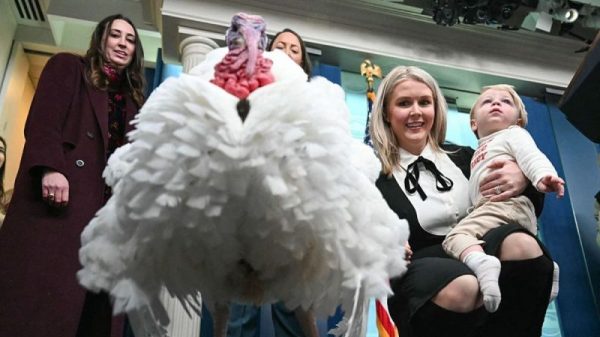After being largely on the sidelines during the debt-and-budget battle in the spring, the Senate is ready to take the lead on the fall legislative session on the outline for government funding and supporting critical national security efforts overseas.
Beginning with a simple resolution to keep agencies open, a bipartisan collection of senators wants to add its priorities to that bill. The group essentially is daring the divided House Republicans to oppose it and take the blame for shutting down the government if the Sept. 30 deadline has not been met.
These senators then expect to use their largely unified position as leverage to get their way in the more detailed agency funding outlines expected in the late fall, while also dominating the split House on negotiations over the annual Pentagon funding policy legislation.
In all, the Senate wants to reimpose its traditional role of regularly jamming the lower chamber into accepting its bipartisan approach to big policy matters.
“Obviously, if you’re from the House perspective, what I would say is this,” said Sen. Chris Van Hollen (D-Md.), who spent 14 years in the House before joining the Senate seven years ago. “You never like it, but you also understand why that’s going to have to be the result. Seriously. I mean, that’s the political math out here.”
Senate Republicans are a bit more diplomatic in their proclamations, aware that House Speaker Kevin McCarthy (R-Calif.) faces a hostile hard-right flank that doesn’t support the Senate positions. But they acknowledge that if McCarthy gets a highly partisan bill narrowly through the House to keep government agencies running, the Senate will send back a much more sweeping bill that has broad bipartisan support.
“They’re going to have to figure out the best way to get this stuff across the floor of the House,” Sen. John Thune (S.D.), the Republican whip, told reporters Thursday. “And then, you know, we would have — however they do it — some flexibility when that all comes over here, about how to marry it all up.”
The exact details are not final, but senators have made clear that they are not going to repeat their decision to sit out the debt debate that took place during the spring. In those talks, President Biden and his top advisers negotiated a multiyear framework with McCarthy that set the overall annual spending limits and increased borrowing authority for the Treasury.
That was an unusual moment when the Senate essentially had to eat the legislative sandwich negotiated by the House. While there was bipartisan disappointment, Senate Republicans in particular felt that McCarthy had cut a bad deal by agreeing to what they considered an insufficient Biden request for $886 billion of defense funding.
This sets up a dicey Republican-vs.-Republican battle in the fall, with McConnell taking the point on voicing Senate GOP support for adding Biden’s $40 billion emergency funding request to the expected stopgap funding bill developed to keep the government open.
He used his daily floor speeches this past week to voice support for shoring up Ukrainian defenses, to the tune of $24 billion of the emergency request. The remaining funds would help natural disaster recovery and a few other urgent matters. He has jabbed at the House GOP’s far-right flank that has joined former president Donald Trump in considering Ukraine as not worth so much money to fight against Russia’s invasion.
“Critics of this investment cannot ignore its returns: American industry and workers are stronger for it. Our warfighters are stronger for it. And our nation is stronger for it,” McConnell said Thursday.
This standoff will play out in at least three steps over the next three months: First, the Sept. 30 deadline to pass a stopgap bill to keep federal agencies running; next, using that extra time to approve detailed agency budgets; and then hammering out differences between the House and Senate’s Pentagon policy bills.
Sen. Lindsey O. Graham (S.C.), a traditional GOP security hawk, sides with those who want to use the stopgap bill as a vehicle to attach the $40 billion emergency funding request, known as a supplemental. And then, by year’s end, Graham would put together a second supplemental request for Ukraine and any other natural disasters. He wants that funding measure to include additional billions of dollars to help other Pentagon accounts because he does not think the McCarthy deal provided enough money.
“Our military’s been hurt by inflation. So a supplemental should have money for our military, it should have money for disasters, it should have money to help Ukraine. It should have many moving parts,” Graham said Wednesday.
In overwhelmingly bipartisan votes, the Senate Appropriations Committee has agreed to an additional $14 billion of “emergency” funding, more than half for the Pentagon, to go above the spending ceilings set by the Biden-McCarthy deal. That money is separate from Biden’s $40 billion supplemental request last month.
All this additional money, with big Senate support, essentially would wipe out the “savings” that McCarthy touted after clinching the deal with Biden. He sold that as a conservative package that reduced spending from 2023 to 2024, winning an impressive two-thirds support from his caucus.
McCarthy initially suggested the $24 billion request for Ukraine should be considered inside the annual funding request for the Defense Department, not in a separate emergency account.
Senators believe their unity, along with the required signature from a Democratic president, gives them all the leverage in negotiations with House counterparts.
“When the Senate’s divided,” Van Hollen said, “it doesn’t have the ability to just send something over to the House and say, ‘This is going to have to be the final product.’”
Lately, it’s been the other way around.
With his hard-right faction issuing various threats, McCarthy has repeatedly ordered his committee chairs to write up very conservative bills — almost all of which are funded well below the Biden-McCarthy targets from the spring debt deal.
That has left House Democrats opposed to the GOP bills, which can pass only by the narrowest of margins without Democratic support.
In July, for example, McCarthy let conservatives pile a bunch of legislative riders related to abortion and other culture war issues onto the Pentagon policy bill. The traditionally bipartisan bill narrowly won approval, 219-210.
Two weeks later, eschewing that approach, the Senate signed off, 86-11, on its bipartisan Pentagon bill.
That disparity just leaves the House at a disadvantage when the two sides have to negotiate differences between their proposals, according to Sen. Kirsten Gillibrand (D-N.Y.), who said that smart tactics involve building bipartisan bridges across the Capitol.
“What should be done, if you want a big bill to pass, you need to do your coalition building in both the House and Senate at the same time,” Gillibrand said.
In 2009 and 2010, when Senate Democrats held a 60-vote, filibuster-proof majority, they dictated outcomes often even over the objections of the powerful House speaker, Rep. Nancy Pelosi (D-Calif.).
No moment caused as much grief among House Democrats as having to swallow the Senate version of the Affordable Care Act. After losing a Massachusetts special election in early 2010, the Senate Democratic caucus held 59 seats, and, with every Republican opposed, could not negotiate a new bill with House Democrats.
Pelosi just had to pass the Senate bill. “That was Exhibit A in terms of getting jammed,” Van Hollen, a House member in 2010, recalled.
In her second stint as speaker, beginning in 2019, Pelosi scored several wins over McConnell and the Senate, who deferred to her to negotiate with Trump’s advisers on several budget and trade deals.
This spring’s Biden-McCarthy deal gave Senate Republicans a sense of déjà vu, and they have been itching to put their imprimatur on legislation ever since.
The speaker’s first move will come in the next 10 days, as he must decide how to pass a bill to keep the government open. Recent history suggests he will cater to the hard right and load up the bill with conservative riders, perhaps on border policy.
Van Hollen thinks this will play out in a way that is somewhat similar to the health-care-debate process: The Senate will pass its version of the stopgap bill, stuffed with Ukraine funding, back into McCarthy’s lap, probably with only a day or two to spare before a government shutdown.
“It was a take-it-or-leave-it thing,” he said of the 2010 showdown.
Senators are betting that McCarthy will have to take it.
After being largely on the sidelines during the debt-and-budget battle in the spring, the Senate is ready to take the lead on the fall legislative session on the outline for government funding and supporting critical national security efforts overseas.
Beginning with a simple resolution to keep agencies open, a bipartisan collection of senators wants to add its priorities to that bill. The group essentially is daring the divided House Republicans to oppose it and take the blame for shutting down the government if the Sept. 30 deadline has not been met.
These senators then expect to use their largely unified position as leverage to get their way in the more detailed agency funding outlines expected in the late fall, while also dominating the split House on negotiations over the annual Pentagon funding policy legislation.
In all, the Senate wants to reimpose its traditional role of regularly jamming the lower chamber into accepting its bipartisan approach to big policy matters.
“Obviously, if you’re from the House perspective, what I would say is this,” said Sen. Chris Van Hollen (D-Md.), who spent 14 years in the House before joining the Senate seven years ago. “You never like it, but you also understand why that’s going to have to be the result. Seriously. I mean, that’s the political math out here.”
Senate Republicans are a bit more diplomatic in their proclamations, aware that House Speaker Kevin McCarthy (R-Calif.) faces a hostile hard-right flank that doesn’t support the Senate positions. But they acknowledge that if McCarthy gets a highly partisan bill narrowly through the House to keep government agencies running, the Senate will send back a much more sweeping bill that has broad bipartisan support.
“They’re going to have to figure out the best way to get this stuff across the floor of the House,” Sen. John Thune (S.D.), the Republican whip, told reporters Thursday. “And then, you know, we would have — however they do it — some flexibility when that all comes over here, about how to marry it all up.”
The exact details are not final, but senators have made clear that they are not going to repeat their decision to sit out the debt debate that took place during the spring. In those talks, President Biden and his top advisers negotiated a multiyear framework with McCarthy that set the overall annual spending limits and increased borrowing authority for the Treasury.
That was an unusual moment when the Senate essentially had to eat the legislative sandwich negotiated by the House. While there was bipartisan disappointment, Senate Republicans in particular felt that McCarthy had cut a bad deal by agreeing to what they considered an insufficient Biden request for $886 billion of defense funding.
This sets up a dicey Republican-vs.-Republican battle in the fall, with McConnell taking the point on voicing Senate GOP support for adding Biden’s $40 billion emergency funding request to the expected stopgap funding bill developed to keep the government open.
He used his daily floor speeches this past week to voice support for shoring up Ukrainian defenses, to the tune of $24 billion of the emergency request. The remaining funds would help natural disaster recovery and a few other urgent matters. He has jabbed at the House GOP’s far-right flank that has joined former president Donald Trump in considering Ukraine as not worth so much money to fight against Russia’s invasion.
“Critics of this investment cannot ignore its returns: American industry and workers are stronger for it. Our warfighters are stronger for it. And our nation is stronger for it,” McConnell said Thursday.
This standoff will play out in at least three steps over the next three months: First, the Sept. 30 deadline to pass a stopgap bill to keep federal agencies running; next, using that extra time to approve detailed agency budgets; and then hammering out differences between the House and Senate’s Pentagon policy bills.
Sen. Lindsey O. Graham (S.C.), a traditional GOP security hawk, sides with those who want to use the stopgap bill as a vehicle to attach the $40 billion emergency funding request, known as a supplemental. And then, by year’s end, Graham would put together a second supplemental request for Ukraine and any other natural disasters. He wants that funding measure to include additional billions of dollars to help other Pentagon accounts because he does not think the McCarthy deal provided enough money.
“Our military’s been hurt by inflation. So a supplemental should have money for our military, it should have money for disasters, it should have money to help Ukraine. It should have many moving parts,” Graham said Wednesday.
In overwhelmingly bipartisan votes, the Senate Appropriations Committee has agreed to an additional $14 billion of “emergency” funding, more than half for the Pentagon, to go above the spending ceilings set by the Biden-McCarthy deal. That money is separate from Biden’s $40 billion supplemental request last month.
All this additional money, with big Senate support, essentially would wipe out the “savings” that McCarthy touted after clinching the deal with Biden. He sold that as a conservative package that reduced spending from 2023 to 2024, winning an impressive two-thirds support from his caucus.
McCarthy initially suggested the $24 billion request for Ukraine should be considered inside the annual funding request for the Defense Department, not in a separate emergency account.
Senators believe their unity, along with the required signature from a Democratic president, gives them all the leverage in negotiations with House counterparts.
“When the Senate’s divided,” Van Hollen said, “it doesn’t have the ability to just send something over to the House and say, ‘This is going to have to be the final product.’”
Lately, it’s been the other way around.
With his hard-right faction issuing various threats, McCarthy has repeatedly ordered his committee chairs to write up very conservative bills — almost all of which are funded well below the Biden-McCarthy targets from the spring debt deal.
That has left House Democrats opposed to the GOP bills, which can pass only by the narrowest of margins without Democratic support.
In July, for example, McCarthy let conservatives pile a bunch of legislative riders related to abortion and other culture war issues onto the Pentagon policy bill. The traditionally bipartisan bill narrowly won approval, 219-210.
Two weeks later, eschewing that approach, the Senate signed off, 86-11, on its bipartisan Pentagon bill.
That disparity just leaves the House at a disadvantage when the two sides have to negotiate differences between their proposals, according to Sen. Kirsten Gillibrand (D-N.Y.), who said that smart tactics involve building bipartisan bridges across the Capitol.
“What should be done, if you want a big bill to pass, you need to do your coalition building in both the House and Senate at the same time,” Gillibrand said.
In 2009 and 2010, when Senate Democrats held a 60-vote, filibuster-proof majority, they dictated outcomes often even over the objections of the powerful House speaker, Rep. Nancy Pelosi (D-Calif.).
No moment caused as much grief among House Democrats as having to swallow the Senate version of the Affordable Care Act. After losing a Massachusetts special election in early 2010, the Senate Democratic caucus held 59 seats, and, with every Republican opposed, could not negotiate a new bill with House Democrats.
Pelosi just had to pass the Senate bill. “That was Exhibit A in terms of getting jammed,” Van Hollen, a House member in 2010, recalled.
In her second stint as speaker, beginning in 2019, Pelosi scored several wins over McConnell and the Senate, who deferred to her to negotiate with Trump’s advisers on several budget and trade deals.
This spring’s Biden-McCarthy deal gave Senate Republicans a sense of déjà vu, and they have been itching to put their imprimatur on legislation ever since.
The speaker’s first move will come in the next 10 days, as he must decide how to pass a bill to keep the government open. Recent history suggests he will cater to the hard right and load up the bill with conservative riders, perhaps on border policy.
Van Hollen thinks this will play out in a way that is somewhat similar to the health-care-debate process: The Senate will pass its version of the stopgap bill, stuffed with Ukraine funding, back into McCarthy’s lap, probably with only a day or two to spare before a government shutdown.
“It was a take-it-or-leave-it thing,” he said of the 2010 showdown.
Senators are betting that McCarthy will have to take it.





















